Business Economics: Demand, Supply, and Market Equilibrium Analysis
VerifiedAdded on 2023/06/18
|6
|1233
|149
Homework Assignment
AI Summary
This assignment delves into key concepts of business economics, focusing on demand and supply analysis. It examines the impact of political and trade tensions between Australia and China on the demand for Australian wine, the effects of rapid income growth in China, and the influence of cheaper French wine prices. The assignment also explores the phenomenon of panic buying of sanitary items during the COVID-19 pandemic in Australia, illustrating the price increase using a demand and supply model and explaining the return to normal price levels as the pandemic came under control. Furthermore, it includes a cost analysis with calculations of fixed cost, variable cost, total cost, average fixed cost, average variable cost, average total cost, and marginal cost, providing a comprehensive overview of microeconomic principles.
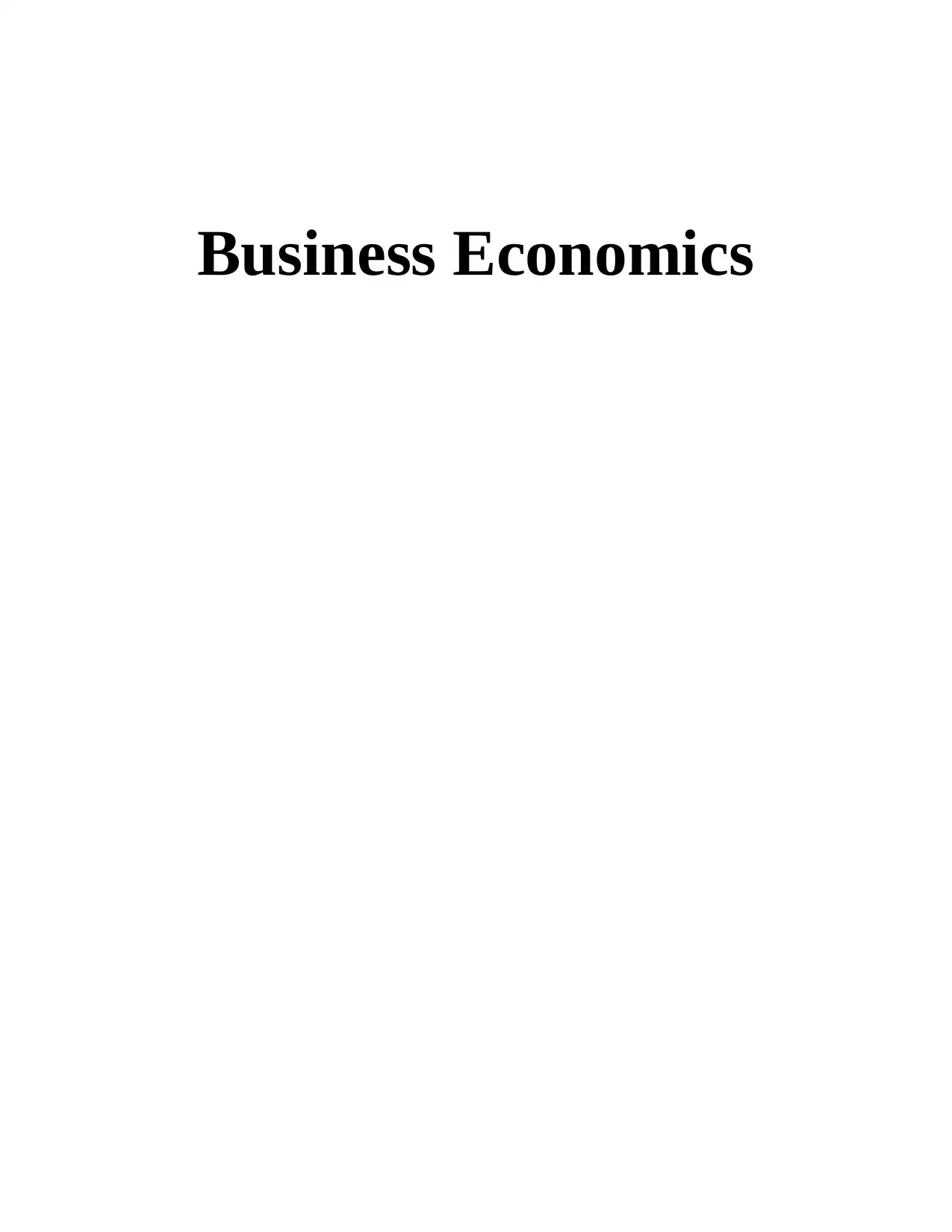
Business Economics
Paraphrase This Document
Need a fresh take? Get an instant paraphrase of this document with our AI Paraphraser
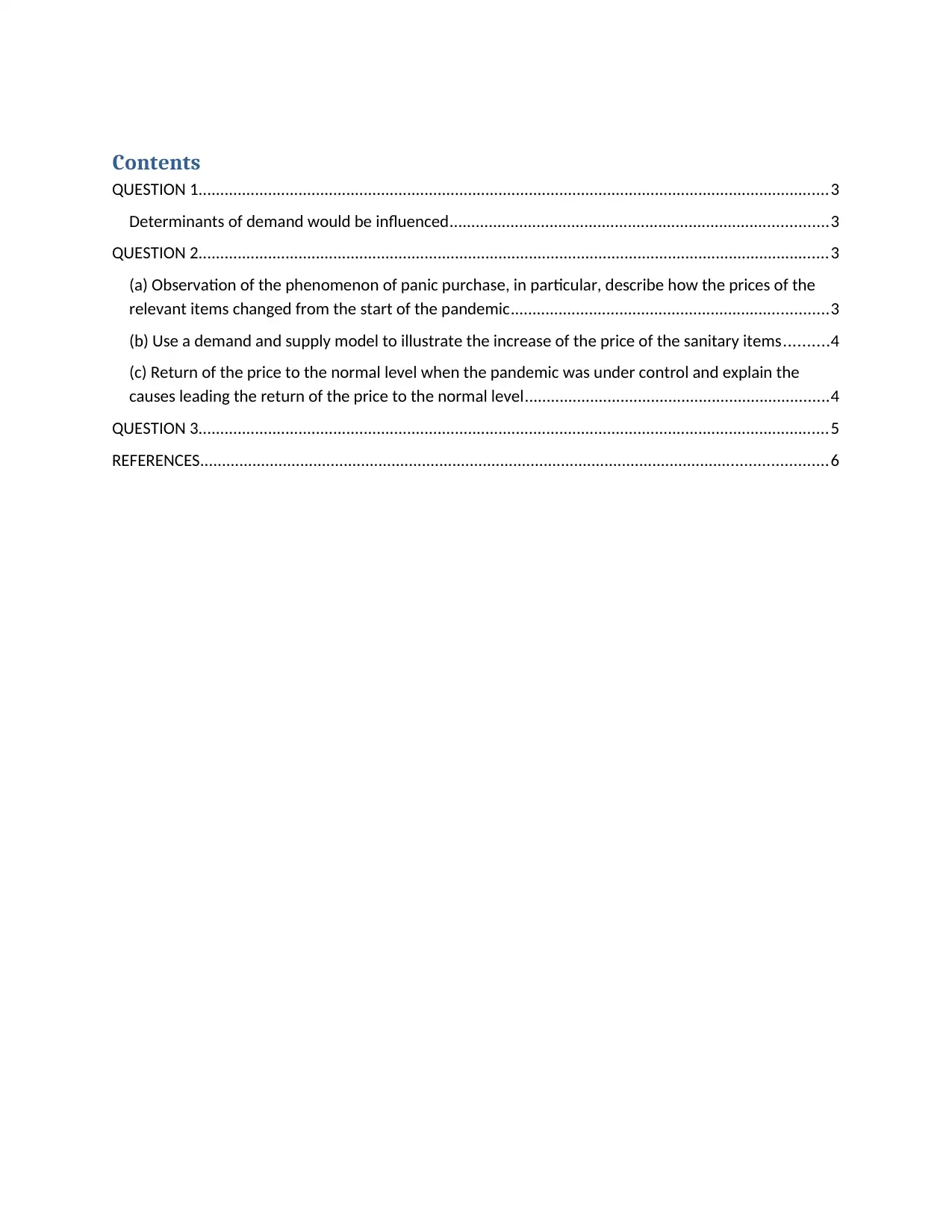
Contents
QUESTION 1.................................................................................................................................................3
Determinants of demand would be influenced.......................................................................................3
QUESTION 2.................................................................................................................................................3
(a) Observation of the phenomenon of panic purchase, in particular, describe how the prices of the
relevant items changed from the start of the pandemic.........................................................................3
(b) Use a demand and supply model to illustrate the increase of the price of the sanitary items..........4
(c) Return of the price to the normal level when the pandemic was under control and explain the
causes leading the return of the price to the normal level......................................................................4
QUESTION 3.................................................................................................................................................5
REFERENCES................................................................................................................................................6
QUESTION 1.................................................................................................................................................3
Determinants of demand would be influenced.......................................................................................3
QUESTION 2.................................................................................................................................................3
(a) Observation of the phenomenon of panic purchase, in particular, describe how the prices of the
relevant items changed from the start of the pandemic.........................................................................3
(b) Use a demand and supply model to illustrate the increase of the price of the sanitary items..........4
(c) Return of the price to the normal level when the pandemic was under control and explain the
causes leading the return of the price to the normal level......................................................................4
QUESTION 3.................................................................................................................................................5
REFERENCES................................................................................................................................................6
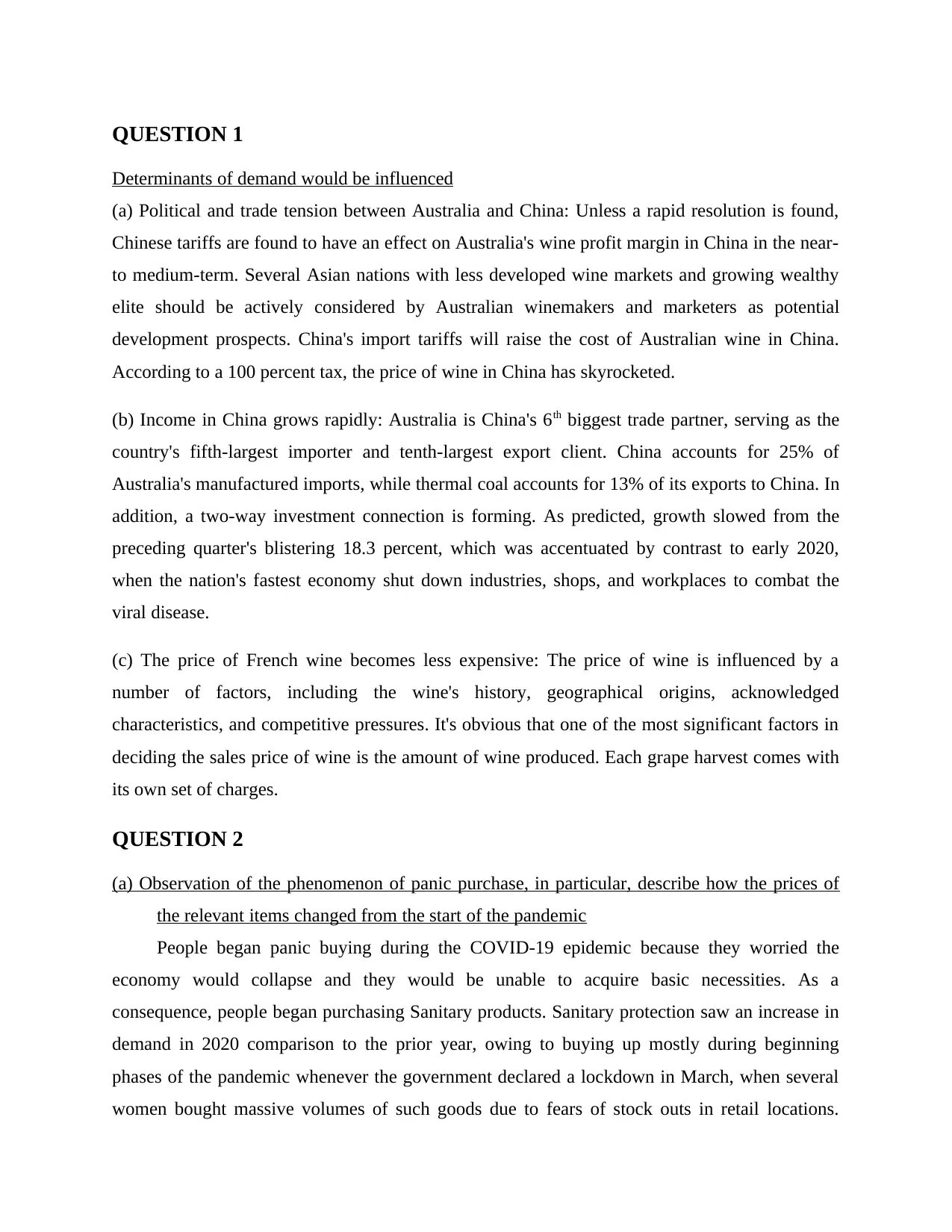
QUESTION 1
Determinants of demand would be influenced
(a) Political and trade tension between Australia and China: Unless a rapid resolution is found,
Chinese tariffs are found to have an effect on Australia's wine profit margin in China in the near-
to medium-term. Several Asian nations with less developed wine markets and growing wealthy
elite should be actively considered by Australian winemakers and marketers as potential
development prospects. China's import tariffs will raise the cost of Australian wine in China.
According to a 100 percent tax, the price of wine in China has skyrocketed.
(b) Income in China grows rapidly: Australia is China's 6th biggest trade partner, serving as the
country's fifth-largest importer and tenth-largest export client. China accounts for 25% of
Australia's manufactured imports, while thermal coal accounts for 13% of its exports to China. In
addition, a two-way investment connection is forming. As predicted, growth slowed from the
preceding quarter's blistering 18.3 percent, which was accentuated by contrast to early 2020,
when the nation's fastest economy shut down industries, shops, and workplaces to combat the
viral disease.
(c) The price of French wine becomes less expensive: The price of wine is influenced by a
number of factors, including the wine's history, geographical origins, acknowledged
characteristics, and competitive pressures. It's obvious that one of the most significant factors in
deciding the sales price of wine is the amount of wine produced. Each grape harvest comes with
its own set of charges.
QUESTION 2
(a) Observation of the phenomenon of panic purchase, in particular, describe how the prices of
the relevant items changed from the start of the pandemic
People began panic buying during the COVID-19 epidemic because they worried the
economy would collapse and they would be unable to acquire basic necessities. As a
consequence, people began purchasing Sanitary products. Sanitary protection saw an increase in
demand in 2020 comparison to the prior year, owing to buying up mostly during beginning
phases of the pandemic whenever the government declared a lockdown in March, when several
women bought massive volumes of such goods due to fears of stock outs in retail locations.
Determinants of demand would be influenced
(a) Political and trade tension between Australia and China: Unless a rapid resolution is found,
Chinese tariffs are found to have an effect on Australia's wine profit margin in China in the near-
to medium-term. Several Asian nations with less developed wine markets and growing wealthy
elite should be actively considered by Australian winemakers and marketers as potential
development prospects. China's import tariffs will raise the cost of Australian wine in China.
According to a 100 percent tax, the price of wine in China has skyrocketed.
(b) Income in China grows rapidly: Australia is China's 6th biggest trade partner, serving as the
country's fifth-largest importer and tenth-largest export client. China accounts for 25% of
Australia's manufactured imports, while thermal coal accounts for 13% of its exports to China. In
addition, a two-way investment connection is forming. As predicted, growth slowed from the
preceding quarter's blistering 18.3 percent, which was accentuated by contrast to early 2020,
when the nation's fastest economy shut down industries, shops, and workplaces to combat the
viral disease.
(c) The price of French wine becomes less expensive: The price of wine is influenced by a
number of factors, including the wine's history, geographical origins, acknowledged
characteristics, and competitive pressures. It's obvious that one of the most significant factors in
deciding the sales price of wine is the amount of wine produced. Each grape harvest comes with
its own set of charges.
QUESTION 2
(a) Observation of the phenomenon of panic purchase, in particular, describe how the prices of
the relevant items changed from the start of the pandemic
People began panic buying during the COVID-19 epidemic because they worried the
economy would collapse and they would be unable to acquire basic necessities. As a
consequence, people began purchasing Sanitary products. Sanitary protection saw an increase in
demand in 2020 comparison to the prior year, owing to buying up mostly during beginning
phases of the pandemic whenever the government declared a lockdown in March, when several
women bought massive volumes of such goods due to fears of stock outs in retail locations.
⊘ This is a preview!⊘
Do you want full access?
Subscribe today to unlock all pages.

Trusted by 1+ million students worldwide
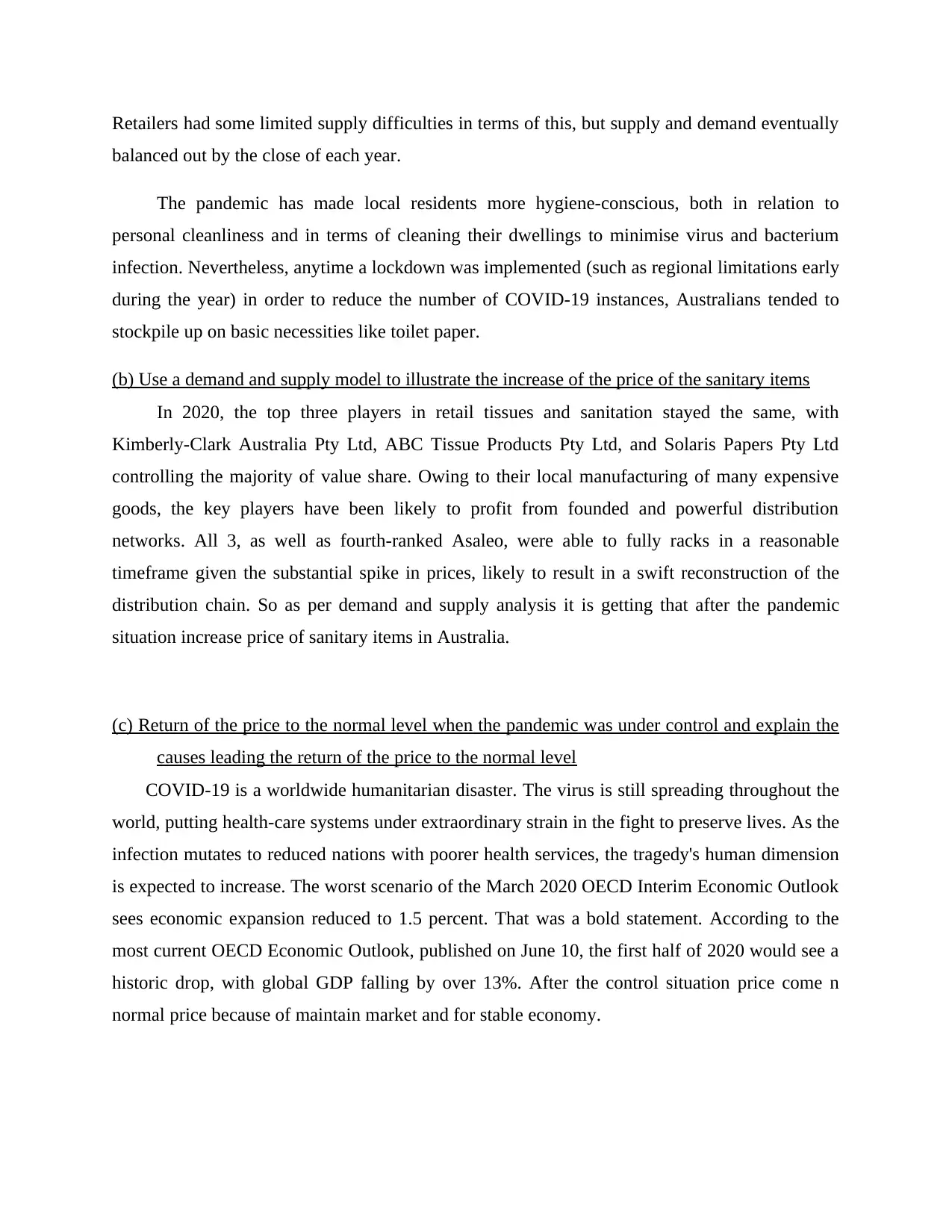
Retailers had some limited supply difficulties in terms of this, but supply and demand eventually
balanced out by the close of each year.
The pandemic has made local residents more hygiene-conscious, both in relation to
personal cleanliness and in terms of cleaning their dwellings to minimise virus and bacterium
infection. Nevertheless, anytime a lockdown was implemented (such as regional limitations early
during the year) in order to reduce the number of COVID-19 instances, Australians tended to
stockpile up on basic necessities like toilet paper.
(b) Use a demand and supply model to illustrate the increase of the price of the sanitary items
In 2020, the top three players in retail tissues and sanitation stayed the same, with
Kimberly-Clark Australia Pty Ltd, ABC Tissue Products Pty Ltd, and Solaris Papers Pty Ltd
controlling the majority of value share. Owing to their local manufacturing of many expensive
goods, the key players have been likely to profit from founded and powerful distribution
networks. All 3, as well as fourth-ranked Asaleo, were able to fully racks in a reasonable
timeframe given the substantial spike in prices, likely to result in a swift reconstruction of the
distribution chain. So as per demand and supply analysis it is getting that after the pandemic
situation increase price of sanitary items in Australia.
(c) Return of the price to the normal level when the pandemic was under control and explain the
causes leading the return of the price to the normal level
COVID-19 is a worldwide humanitarian disaster. The virus is still spreading throughout the
world, putting health-care systems under extraordinary strain in the fight to preserve lives. As the
infection mutates to reduced nations with poorer health services, the tragedy's human dimension
is expected to increase. The worst scenario of the March 2020 OECD Interim Economic Outlook
sees economic expansion reduced to 1.5 percent. That was a bold statement. According to the
most current OECD Economic Outlook, published on June 10, the first half of 2020 would see a
historic drop, with global GDP falling by over 13%. After the control situation price come n
normal price because of maintain market and for stable economy.
balanced out by the close of each year.
The pandemic has made local residents more hygiene-conscious, both in relation to
personal cleanliness and in terms of cleaning their dwellings to minimise virus and bacterium
infection. Nevertheless, anytime a lockdown was implemented (such as regional limitations early
during the year) in order to reduce the number of COVID-19 instances, Australians tended to
stockpile up on basic necessities like toilet paper.
(b) Use a demand and supply model to illustrate the increase of the price of the sanitary items
In 2020, the top three players in retail tissues and sanitation stayed the same, with
Kimberly-Clark Australia Pty Ltd, ABC Tissue Products Pty Ltd, and Solaris Papers Pty Ltd
controlling the majority of value share. Owing to their local manufacturing of many expensive
goods, the key players have been likely to profit from founded and powerful distribution
networks. All 3, as well as fourth-ranked Asaleo, were able to fully racks in a reasonable
timeframe given the substantial spike in prices, likely to result in a swift reconstruction of the
distribution chain. So as per demand and supply analysis it is getting that after the pandemic
situation increase price of sanitary items in Australia.
(c) Return of the price to the normal level when the pandemic was under control and explain the
causes leading the return of the price to the normal level
COVID-19 is a worldwide humanitarian disaster. The virus is still spreading throughout the
world, putting health-care systems under extraordinary strain in the fight to preserve lives. As the
infection mutates to reduced nations with poorer health services, the tragedy's human dimension
is expected to increase. The worst scenario of the March 2020 OECD Interim Economic Outlook
sees economic expansion reduced to 1.5 percent. That was a bold statement. According to the
most current OECD Economic Outlook, published on June 10, the first half of 2020 would see a
historic drop, with global GDP falling by over 13%. After the control situation price come n
normal price because of maintain market and for stable economy.
Paraphrase This Document
Need a fresh take? Get an instant paraphrase of this document with our AI Paraphraser
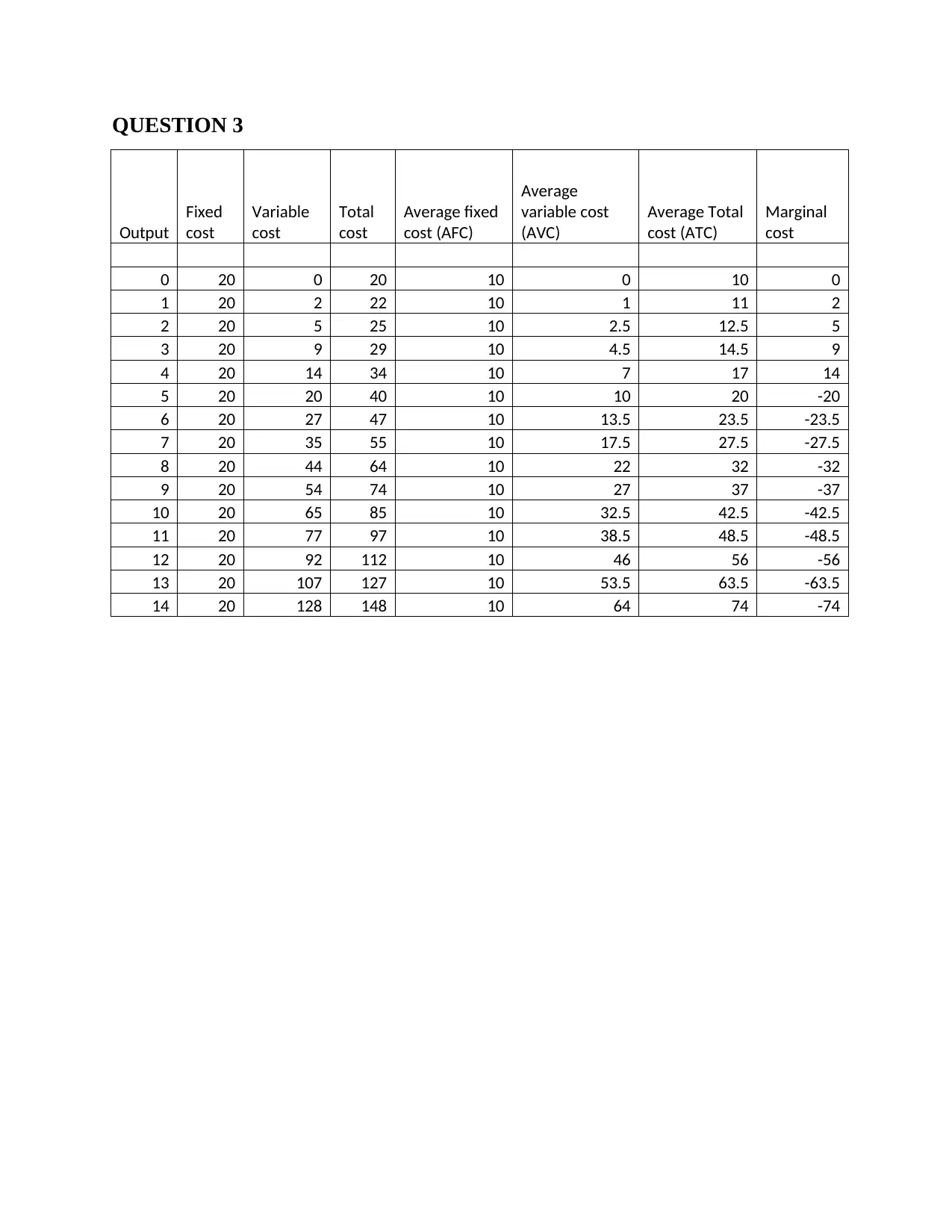
QUESTION 3
Output
Fixed
cost
Variable
cost
Total
cost
Average fixed
cost (AFC)
Average
variable cost
(AVC)
Average Total
cost (ATC)
Marginal
cost
0 20 0 20 10 0 10 0
1 20 2 22 10 1 11 2
2 20 5 25 10 2.5 12.5 5
3 20 9 29 10 4.5 14.5 9
4 20 14 34 10 7 17 14
5 20 20 40 10 10 20 -20
6 20 27 47 10 13.5 23.5 -23.5
7 20 35 55 10 17.5 27.5 -27.5
8 20 44 64 10 22 32 -32
9 20 54 74 10 27 37 -37
10 20 65 85 10 32.5 42.5 -42.5
11 20 77 97 10 38.5 48.5 -48.5
12 20 92 112 10 46 56 -56
13 20 107 127 10 53.5 63.5 -63.5
14 20 128 148 10 64 74 -74
Output
Fixed
cost
Variable
cost
Total
cost
Average fixed
cost (AFC)
Average
variable cost
(AVC)
Average Total
cost (ATC)
Marginal
cost
0 20 0 20 10 0 10 0
1 20 2 22 10 1 11 2
2 20 5 25 10 2.5 12.5 5
3 20 9 29 10 4.5 14.5 9
4 20 14 34 10 7 17 14
5 20 20 40 10 10 20 -20
6 20 27 47 10 13.5 23.5 -23.5
7 20 35 55 10 17.5 27.5 -27.5
8 20 44 64 10 22 32 -32
9 20 54 74 10 27 37 -37
10 20 65 85 10 32.5 42.5 -42.5
11 20 77 97 10 38.5 48.5 -48.5
12 20 92 112 10 46 56 -56
13 20 107 127 10 53.5 63.5 -63.5
14 20 128 148 10 64 74 -74
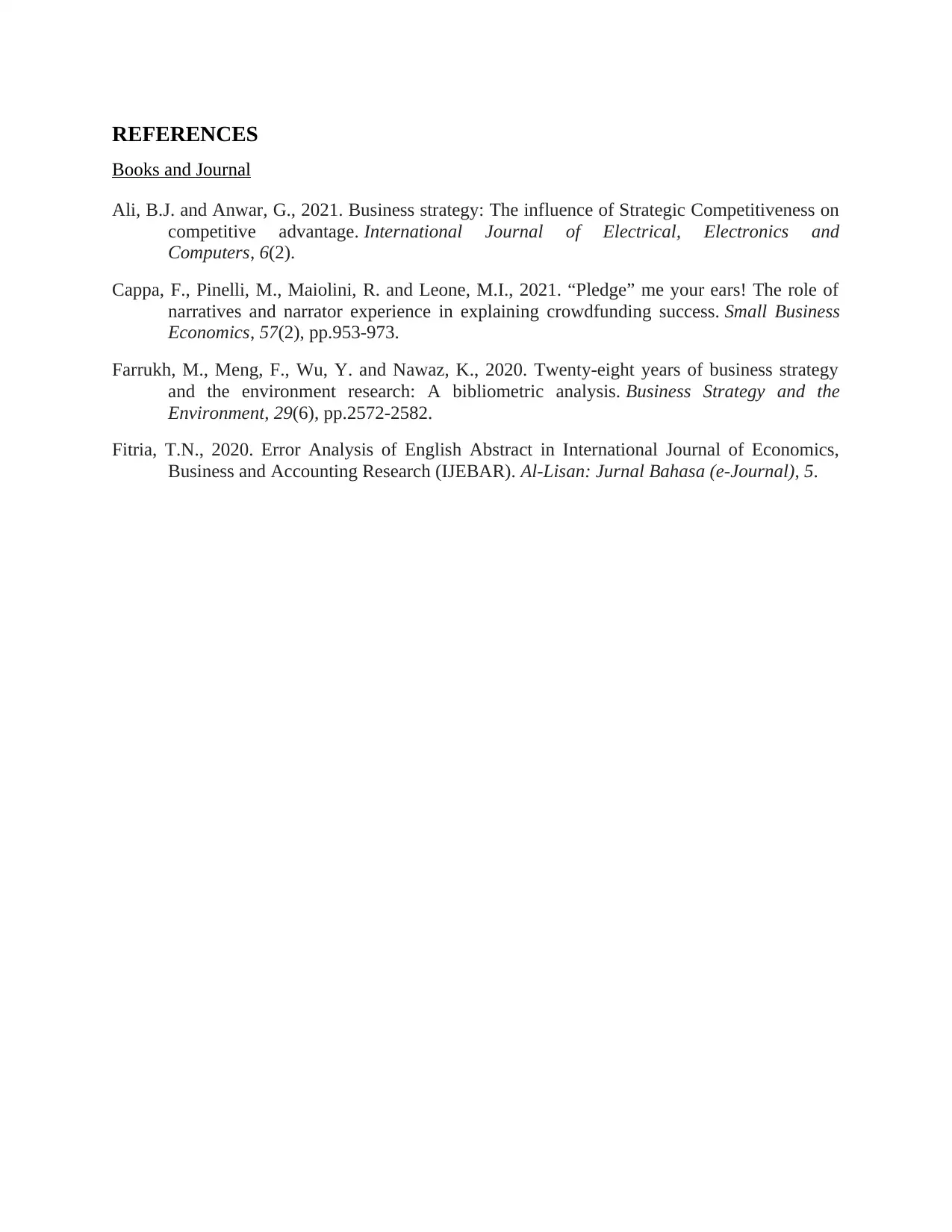
REFERENCES
Books and Journal
Ali, B.J. and Anwar, G., 2021. Business strategy: The influence of Strategic Competitiveness on
competitive advantage. International Journal of Electrical, Electronics and
Computers, 6(2).
Cappa, F., Pinelli, M., Maiolini, R. and Leone, M.I., 2021. “Pledge” me your ears! The role of
narratives and narrator experience in explaining crowdfunding success. Small Business
Economics, 57(2), pp.953-973.
Farrukh, M., Meng, F., Wu, Y. and Nawaz, K., 2020. Twenty‐eight years of business strategy
and the environment research: A bibliometric analysis. Business Strategy and the
Environment, 29(6), pp.2572-2582.
Fitria, T.N., 2020. Error Analysis of English Abstract in International Journal of Economics,
Business and Accounting Research (IJEBAR). Al-Lisan: Jurnal Bahasa (e-Journal), 5.
Books and Journal
Ali, B.J. and Anwar, G., 2021. Business strategy: The influence of Strategic Competitiveness on
competitive advantage. International Journal of Electrical, Electronics and
Computers, 6(2).
Cappa, F., Pinelli, M., Maiolini, R. and Leone, M.I., 2021. “Pledge” me your ears! The role of
narratives and narrator experience in explaining crowdfunding success. Small Business
Economics, 57(2), pp.953-973.
Farrukh, M., Meng, F., Wu, Y. and Nawaz, K., 2020. Twenty‐eight years of business strategy
and the environment research: A bibliometric analysis. Business Strategy and the
Environment, 29(6), pp.2572-2582.
Fitria, T.N., 2020. Error Analysis of English Abstract in International Journal of Economics,
Business and Accounting Research (IJEBAR). Al-Lisan: Jurnal Bahasa (e-Journal), 5.
⊘ This is a preview!⊘
Do you want full access?
Subscribe today to unlock all pages.

Trusted by 1+ million students worldwide
1 out of 6
Related Documents
Your All-in-One AI-Powered Toolkit for Academic Success.
+13062052269
info@desklib.com
Available 24*7 on WhatsApp / Email
![[object Object]](/_next/static/media/star-bottom.7253800d.svg)
Unlock your academic potential
Copyright © 2020–2025 A2Z Services. All Rights Reserved. Developed and managed by ZUCOL.




